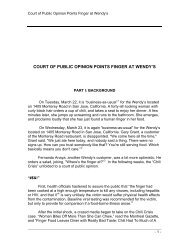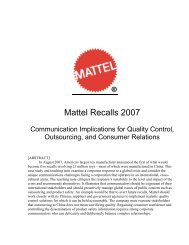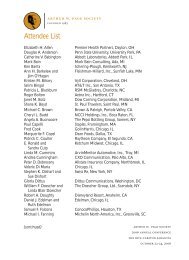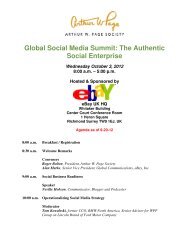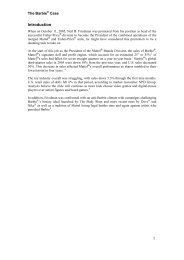The Barbie Case - The Arthur Page Society
The Barbie Case - The Arthur Page Society
The Barbie Case - The Arthur Page Society
You also want an ePaper? Increase the reach of your titles
YUMPU automatically turns print PDFs into web optimized ePapers that Google loves.
Abstract<br />
WINNING ENTRIES – COMMUNICATIONS/JOURNALISM SCHOOLS<br />
first place<br />
Yuliya Melnyk, Moushumi Anand<br />
Faculty Adviser: María Len-Ríos<br />
University of Missouri-Columbia<br />
How the Russian Company Pallet Trucks Used<br />
Public Relations Strategies to Protect its Business<br />
and the German Brand Pfaff-silberblau in Russia in 2001<br />
This case shows how crises can occur in a global economy. It<br />
describes how two companies, a German manufacturer and<br />
Russian retailer, partnered to combat a crisis when<br />
competitors started selling fake copies of the manufacturer’s<br />
“brand” equipment. Pfaff-silberblau is an established<br />
international company, headquartered in Germany, that<br />
manufactures lifting and handling equipment. Pallet Trucks,<br />
at the time, was its exclusive Russian vendor.<br />
While it is thought that smaller products such as make-up<br />
and electronic goods are easier to reproduce as fakes, it is<br />
assumed that heavy equipment like Jeeps or industrial goods<br />
cannot be easily duplicated. This case proves otherwise. Fake<br />
lifting and handling equipment was produced in a Chinese<br />
factory and sold in Russia under the Pfaff-silberblau brand<br />
name. As the counterfeit equipment began to cause profit<br />
losses and decreased consumer confidence in their brands,<br />
the companies worked together proactively, learned from the<br />
experience of their predecessors in new markets, and<br />
protected their brands. Specifically, this case highlights how<br />
public relations techniques can be used to address brand<br />
piracy in developing economies and New Independent<br />
Countries, when legal avenues are not feasible.<br />
A Short History of Branding<br />
It is an ancient practice to put markings on products to<br />
indicate who owned or made an item. For instance, the<br />
paintings on the walls of the Lascaux Caves in southern<br />
France contain marks that scholars say indicate ownership.<br />
<strong>The</strong>se paintings were made 5,000 years ago. Artisans used<br />
stone seals to indicate the manufacturer, and some found in<br />
the Middle East date back to 3500 B.C. (Infoplease Web site,<br />
2005). Not only did the marks indicate quality, but they also<br />
arthur w. page society<br />
let people know whom to blame if there was a problem with<br />
the product. A trademark can be found on the bottom of a<br />
sandal dated from 200 BC (Barlow & Stewart, 2004, p. 24).<br />
During the Middle Ages, trade guilds also began using marks<br />
to indicate who made a specific product. Bell makers were<br />
among the first to adopt the practice, followed by other<br />
manufacturers including paper makers. <strong>The</strong>y added<br />
watermarks so people would know who made a particular<br />
sheet.<br />
In 1266, the Bakers Marking Law, which governed the use of<br />
stamps or pinpricks on loaves of bread, was passed on. It is<br />
one of the earliest known laws on trademarks. Silversmiths<br />
were required to mark their products in 1363. Bottle makers<br />
and manufacturers followed suit, possibly influenced by<br />
Chinese porcelain, which bore markings indicating origin.<br />
One of the earliest court cases involving the improper use of<br />
a trademark occurred in England in 1618. <strong>The</strong> manufacturer<br />
of high-quality cloth sued a competitor who produced lowerquality<br />
cloth, but used the marking reserved for top-quality<br />
cloth. <strong>The</strong> case Southern v. How is considered the first case of<br />
actual trademark infringement. In 1876 England, the Bass<br />
Red Triangle was the first trademark to be registered<br />
(Feldwick, 1991, p. 19).<br />
Trademark Laws in the U.S.<br />
In the U.S., Thomas Jefferson urged the adoption of laws<br />
governing trademarks because of a 1791 dispute over sail<br />
cloth marks. While federal legislation was not forthcoming,<br />
some states passed their own laws. For instance, in 1842,<br />
Michigan required marks to indicate the origin of timber.<br />
41



